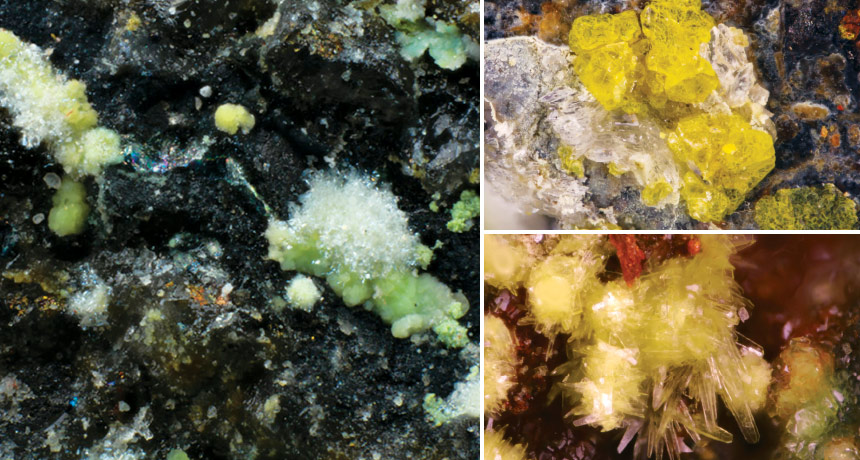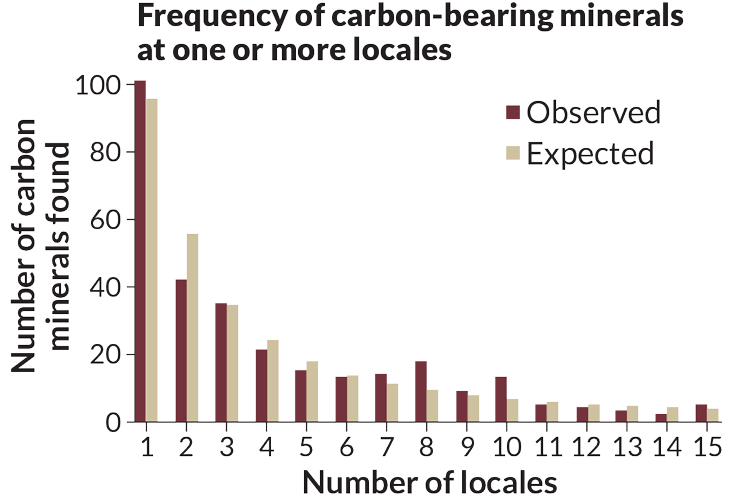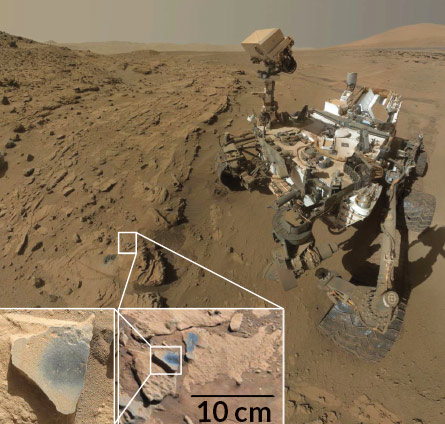Rock hounds are on the hunt for new carbon minerals
A new challenge has scientists searching for dozens of unknown, beguiling crystals

CAN YOU DIG IT? Abellaite, ewingite and leószilárdite (clockwise from left) are three of the seven carbon-bearing minerals recognized by the International Mineralogical Association in the past year. A search is on to find dozens more undiscovered carbon minerals.
Left: Matteo Chinellato; right: Travis Olds
Like many abandoned mines, the Eureka uranium mine in northern Spain is a maze of long, dank tunnels. Water seeping down the walls carries dissolved substances that percolated through rocks overhead. As the water evaporates into the tunnels’ cool air, some of those dissolved ingredients combine to make new substances in solid form.
“The mine is a crystallization factory of weird minerals,” says Jordi Ibáñez-Insa, a physicist at the Institute of Earth Sciences Jaume Almera in Barcelona.
Including the uranium-bearing ores that attracted miners to Eureka in the first place, scientists visiting the mine have cataloged 61 different minerals — solids that have a distinct chemical recipe and arrangement of atoms. The latest find, called abellaite, is a rarity that grows in small pincushions of tiny crystalline needles about 40 to 50 micrometers long. Discovered in July 2010, the mineral has been found only on the walls of a 3-meter-long stretch of one tunnel, says Ibáñez-Insa.
Abellaite is uncommon in another sense: It contains carbon. Of the 5,161 minerals characterized by scientists and recognized by the International Mineralogical Association, just 8 percent, or 416, include carbon.
The Carbon Mineral Challenge, launched last December and running until September 2019, exhorts researchers to scour the landscape — and their museum drawers — for unknown carbon-bearing minerals. In a recent analysis, scientists estimate that there are at least 548 carbon minerals on Earth. That means well over 100 are waiting to be noticed.
The analysis, published in the April American Mineralogist, even provides clues about where scientists and rock hounds should look and what recipes and atomic arrangements such minerals might have.
Survey says
The number of minerals found at only one locale is expected to decrease as more minerals are found. But of all known carbon-bearing minerals (maroon bars), most have been found in only a handful of places. Anticipated finds (tan bars) based on statistical analyses, offer hope of yet-to-be-found minerals.

Source: R. Hazen et al/American Mineralogist 2016
The hunt for carbon minerals is much more than stamp (or rock) collecting. The challenge aims to identify minerals that could help tell the story of the planet’s carbon and water cycles — past and present. Besides having a specific recipe and structure, minerals form only in certain conditions (on Earth and elsewhere), making them keen chroniclers of the environments that existed at the time and place they formed, as well as the conditions since then.
A census of minerals
A few minerals are, forgive the phrase, as common as dirt. Of the more than 5,000 recognized minerals, about 100 have been reported by geologists and amateur collectors at more than 1,000 sites worldwide. Many more are very rare: At least 1,000 minerals have been found in only one locale, says Robert Hazen, a geophysicist at the Carnegie Institution for Science in Washington, D.C. More than half of the world’s minerals have been found at five or fewer locations.
Not every mineral on Earth has been discovered, of course. But by analyzing a massive database of known minerals and how common or rare they are, scientists can use a standard statistical tool to estimate the number of minerals yet to be uncovered. Hazen and his colleagues suggest in the August 2015 issue of Mathematical Geosciences that there are at least 1,500 undiscovered minerals out there. About 140 of those minerals contain carbon, the team predicted in the follow-on analysis published in April.
Both professional mineralogists and amateur collectors can participate in the Carbon Mineral Challenge, but any potential discoveries have to survive the strict screening process of the International Mineralogical Association, which Ibáñez-Insa and a raft of colleagues navigated for abellaite. (The mineral was approved in December 2015.) The researchers submitted a portfolio of data — the sample’s appearance, chemical makeup, arrangement of atoms, color, hardness, transparency, fluorescence, a proposed name and more — to the IMA’s Commission on New Minerals, Nomenclature and Classification.
Promising places
In the search for hidden carbon-bearing minerals, scientists and rock hounds aspiring to geologic fame should visit these locales (or analyze samples already collected there).

A few dozen new minerals are recognized each year, says Hans-Peter Schertl, a mineralogist at Ruhr University in Bochum, Germany, and an IMA officer. Approval can be straightforward, or it can drag out for months or longer, especially if additional data are required, Schertl says. One strict requirement is that a sample be natural, not lab-made or a result of human interference. Thus, any unusual crystals that grow on the surfaces of rocks that were pulled from a mine and then dumped nearby and exposed to the elements wouldn’t qualify as a mineral, he notes, “Those would just be pretty crystals.”
Oddly, the “natural sample” requirement long prevented official recognition of what is purported to be the most common mineral on Earth. Bridgmanite, an iron- and magnesium-rich silicate, received the IMA seal of approval only in 2014 (SN: 1/10/15, p. 4). Estimated to make up a whopping 38 percent of the planet’s volume, bridgmanite can exist only at the high pressures found between 660 and 2,900 kilometers below Earth’s surface — too deep to dig up. Scientists had long studied lab-made samples but hadn’t found a natural bit of the mineral until earlier this decade in a meteorite that landed in Australia in 1879.
Where to look
In their analysis published in April, Hazen and colleagues included general recipes for a variety of Earth’s yet-to-be-discovered carbon minerals. One formula — a complex mix of sodium, lead and carbonate and hydroxyl ions, written scientifically as NaPb2(CO3)2(OH) — matches abellaite from the Spanish mine. Bingo. One more carbon mineral in the bag.
Many of those “missing” minerals will be very similar to known forms, with combinations that differ by only a single element — swapping out a magnesium atom for a calcium atom in the recipe for a known mineral, for example, or a sodium atom for a potassium atom.
“The chemical formula tells you a lot about the conditions that a mineral forms in,” says Daniel Hummer, a geochemist at Southern Illinois University in Carbondale and lead scientist for the Carbon Mineral Challenge. It also suggests that existing minerals that have a very similar formula can, in many cases, serve as a guide for what the missing minerals might look like, in terms of the colors or shapes of their crystals.
In fact, similarities could be so strong that a mineral might be overlooked because it looks so much like a known, or even common, mineral. “It’s possible that some of these missing minerals are hiding in plain sight,” Hummer notes.
If not camouflaged, some carbon minerals may simply be so scarce that they’ve never been encountered. In June in American Mineralogist, Hazen and environmental scientist Jesse Ausubel of Rockefeller University in New York City discuss several reasons why minerals can be rare — so rare, in fact, that the entire world’s supply might fit into a thimble, Hazen says.
First, a mineral might form or remain stable only in extremely unusual combinations of temperature, pressure and pH. The mineral hatrurite (Ca3SiO5), for example, forms only at temperatures above 1,250° Celsius and only in the absence of aluminum, the third most common element in Earth’s crust. Hatrurite was first found in Israel, in an ancient limestone deposit that was probably exposed to intense heat generated when hydrocarbons in nearby sediments burned.
Second, a mineral might include chemical elements that are rare to begin with and even rarer in combination. Examples include swedenborgite (which contains the scarce combination of beryllium and antimony) and any mineral that includes tellurium, which on average is found in Earth’s crust at concentrations of 5 parts per billion.
Third, a mineral may be exceptionally ephemeral. Some are so hygroscopic, or humidity-absorbing, that they pull moisture from the air and dissolve themselves, Hazen says. Hygroscopic minerals have to be collected or observed in the field as they form and before they disappear. Then there are the minerals that form in conditions so remote or harsh that scientists hardly ever get near them (think deep-sea hydrothermal vents or active volcanoes).
Some minerals present more than one of these challenges. Consider fingerite, Cu11O2(VO4)6, an unstable shiny black mineral that forms only at high temperatures and includes the rare combination of copper and vanadium. This exceedingly rare mineral is known only from samples recovered from rocks near heat-belching fissures and holes atop El Salvador’s Izalco volcano.
There are less hostile places to search for new minerals, though. Fourteen sites worldwide, including mines, have each given up 20 or more carbon minerals, Hazen says. Scientists could revisit those 14 sites and look for more unrecognized minerals, he notes. Or they could simply take a closer look at or perform additional tests on samples already collected from such locales.

Or researchers could target areas where ephemeral minerals could be expected to form, if ever so briefly. For example, calcium carbide — a substance produced on an industrial scale to create acetylene for miner’s lamps — reacts so quickly with water that it hasn’t been found in a natural setting. But small, short-lived quantities might be produced when lightning strikes near rocks containing both limestone and coal (admittedly, a pretty hostile situation).
There’s no reason to be limited by the 14 promising locations. Scientists found the yellowish-white crystals of tinnunculite (C5H4N4O3•2H2O), mineral just recognized in December, in an unexpected milieu: inside the residue of bird poop that had landed on extremely hot rocks overlying an underground coal fire in northwestern Russia. The elevated temperatures drive the crystallization of uric acid in the excrement, the researchers say.
The exotic mineral was dubbed tinnunculite to honor the European kestrel (Falco tinnunculus), whose indispensable contribution to mineralogy cannot be denied.
For his part, Ibáñez-Insa plans to spend more time at Spain’s Eureka mine. Although the site’s uranium ores are no longer worth extracting, scientific treasures akin to abellaite may still lie undiscovered. “I’m pretty sure,” he says, “we’ll find some more new minerals there.”
Curious about Martian minerals
The latest discoveries of carbon-bearing minerals haven’t yet led to revelations about Earth’s history. But some new mineral finds by NASA’s Curiosity rover (right) suggest that Mars’ past may have been different than thought.
In 2014, Curiosity drilled into layered sediments with veins of hard, black, manganese-rich minerals within softer strata of sandstone and siltstone (inset), says Nina Lanza, a planetary scientist at Los Alamos National Laboratory in New Mexico. A dearth of chlorine or sulfur atoms (two plausible chemical partners for manganese) plus a lack of carbon above levels normally seen in the Martian atmosphere strongly suggests that the minerals are manganese oxides, she and colleagues reported July 28 in Geophysical Research Letters.
But Mars’ oxygen levels are too low for such minerals to form; on Earth, manganese oxides formed only after atmospheric concentrations of oxygen rose above 1 percent. (On Earth today, oxygen levels in the air are just below 21 percent. On Mars, levels are only about 0.15 percent.)
So where did Mars’ ancient wealth of oxygen come from? Probably not from oxygen-making microorganisms, Lanza says. Since Mars has no protective magnetic field (SN: 9/19/15, p. 5), the oxygen might have come from radiation-triggered breakdown of water vapor in the air; perhaps lighter hydrogen molecules were lost to space while the slower, heavier oxygen molecules accumulated.
The new results, Lanza says, also suggest that finding signs of oxygen on planets around distant suns wouldn’t be a slam dunk sign of life there.
At another site, Curiosity found tridymite, a silicon dioxide that forms above 870° Celsius, where flows of silica-rich lava cool, says Richard Morris, a geochemist at NASA’s Johnson Space Center in Houston. The Red Planet may have had a much more violent volcanic history than suspected, he and colleagues reported June 28 in the Proceedings of the National Academy of Sciences. — Sid Perkins
This article appears in the October 15, 2016, issue of Science News with the headline, “Digging Carbon: A new challenge has scientists searching for dozens of unknown, beguiling crystals.”







